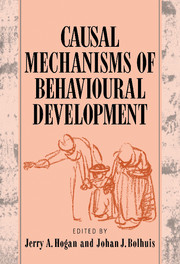Book contents
- Frontmatter
- Contents
- List of contributors
- Foreword: Introducing Jaap Kruijt
- Preface
- Part one Introduction
- Part two Development of perceptual and motor mechanisms
- Part three Development of behaviour systems
- Part four Development of cognition
- Part five Learning and development
- 14 Behavioral change as a result of experience: toward principles of learning and development
- 15 The varieties of learning in development: toward a common framework
- 16 Representation development in associative systems
- Author index
- Subject index
16 - Representation development in associative systems
Published online by Cambridge University Press: 19 January 2010
- Frontmatter
- Contents
- List of contributors
- Foreword: Introducing Jaap Kruijt
- Preface
- Part one Introduction
- Part two Development of perceptual and motor mechanisms
- Part three Development of behaviour systems
- Part four Development of cognition
- Part five Learning and development
- 14 Behavioral change as a result of experience: toward principles of learning and development
- 15 The varieties of learning in development: toward a common framework
- 16 Representation development in associative systems
- Author index
- Subject index
Summary
This chapter is concerned with mental representations, and their development by learning via association. By representation, I mean to imply structures that permit recognition and identification of a stimulus without necessarily entering the conceptual domain. I hope to show that associative mechanisms can construct and employ representations of this type in such a way as to permit explanation of phenomena such as latent inhibition, perceptual learning, and the trade-off between context-specificity and generalisation. To this end, an outline model of associative learning, that concerns itself with the formation of associations between elements representing motivationally neutral stimuli, is developed in the course of the chapter. The emphasis, however, will be on the representational assumptions contained within the model and their consequences. The chapter starts by examining an elemental approach to stimulus representation, which proves surprisingly powerful in an associative context. Nevertheless, there are drawbacks to an elemental approach, which the latter half of the chapter attempts to solve by invoking a configural modification of an elemental account.
Introduction
The modern concept of an association, and hence of an associative learning system, probably stems from the work of the British empiricists (e.g. Locke, Hume). At the heart of this approach is the essential idea that one stimulus can bring about some recollection of another by virtue of the fact that the two stimuli were associated at some time in the past.
- Type
- Chapter
- Information
- Causal Mechanisms of Behavioural Development , pp. 377 - 402Publisher: Cambridge University PressPrint publication year: 1994
- 7
- Cited by



